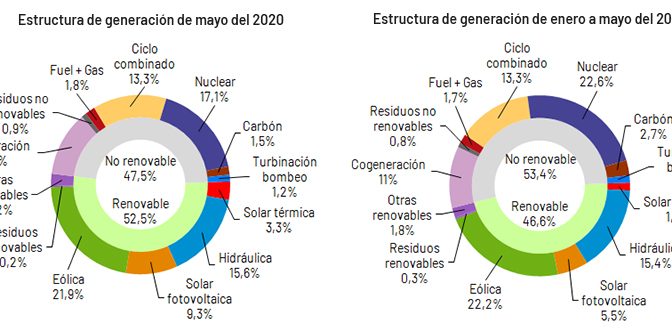Wind energy represented 21.9% of the electricity demand in Spain in May, concentrated solar power 3.3% and photovoltaic energy 9, 3%. 52.5% of the monthly generation was from renewable sources and 70.8% were produced from technologies that do not emit CO2 equivalent. The demand for electrical energy decreased in the Balearic Islands by 31.3% and in the Canary Islands by 18.8% compared to the same month of 2019.
Red Eléctrica de España publishes the electricity demand corresponding to the month of May, the second full month under the state of alarm on the occasion of the COVID-19, which has meant the start of the de-escalation and, consequently, an increase in the economic activity. In this context, the national electricity demand for May is estimated at 18,366 GWh, 13.1% lower than that registered in the same month of the previous year. If the effects of the calendar and the temperatures are taken into account, the figure is 13.6% less than in May 2019. This decrease is somewhat less than that registered last April, when national demand was 17,003 GWh That is to say, 17.8% lower than that registered in the same month of the previous year.
In the first five months of 2020, demand is estimated at 101,010 GWh, 7.8% less than in 2019. In this case, once the influence of calendar and temperatures has been corrected, demand is 7.7% lower than that registered in the same period of the previous year.
In the month of May and according to estimated data today, generation from renewable energy sources represented 52.5% of production. From January to May, renewable generation reaches 46.6% of the total electricity balance. Thus, the month of May has been the third month in the last decade to achieve the highest rate of renewable generation, behind that registered in February 2014 (55.7%) and in March 2018 (54.7%).
In this month, 70.8% of electricity production came from technologies that do not emit CO2 equivalent.
With information available today, wind production in May reached 3,968 GWh, which is 15.2% less than the same period last year, and accounted for 21.9% of national production.
The demand for electrical energy falls 12.5% ??in the peninsular electricity system
In the peninsular electricity system, the demand for May is estimated at 17,417 GWh, 12.5% ??lower than that registered in the same month of the previous year. If the effects of the calendar and the temperatures are taken into account, the demand is 13% less than that of May 2019.
In the first five months of 2020, the demand for electrical energy in the Peninsula is estimated at 95,655 GWh, 7.7% less than in 2019. In this case, once the influence of calendar and temperatures has been corrected, demand it is 7.6% lower than that registered in the same period of the previous year.
During this month and according to data estimated today, 54.5% of the peninsular generation was of renewable origin and 73.8% came from technologies that do not emit CO2 equivalent. For its part, wind registered 3,894 GWh, 15% lower than in May last year, and contributed 22.6% to the mix.
Demand for electrical energy fell 31.3% in the Balearic Islands and 18.8% in the Canary Islands in May
In the Balearic Islands, the demand for electrical energy in May is estimated at 327,927 MWh, 31.3% lower than that registered in the same month of the previous year. If the effects of the calendar and temperatures are taken into account, the figure decreases 32.6% compared to May 2019. In the first five months of 2020, Balearic demand is estimated at 1,912,726 MWh, a 15, 1% less than in 2019.
The combined cycle, with 77.2% of the total, was the Balearic Islands’ first source of electricity generation, where renewable technologies that do not emit CO2 equivalent represented 7.6%. For the fifth consecutive month, coal did not produce any MWh in the Balearic electricity system.
For its part, in the Canary archipelago the demand for electricity is estimated at 588,254 MWh, 18.8% lower than that registered in May 2019. If the effects of the calendar and temperatures are taken into account, the figure decreases by 18 , 5% with respect to the same month of the previous year. So far in 2020, demand in the Canary Islands is estimated at 3,280,162 MWh and falls by 8.8% compared to the same period of the previous year.
In May and according to estimated data, the combined cycle was the leading technology in the Canary Islands generation mix, with a contribution of 39.9%. Renewables and emission-free technologies represented 16.8% of the Canarian generation.

